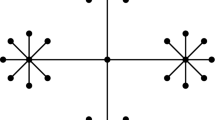Abstract
The theory of the tight span, a cell complex that can be associated to every metric D, offers a unifying view on existing approaches for analyzing distance data, in particular for decomposing a metric D into a sum of simpler metrics as well as for representing it by certain specific edge-weighted graphs, often referred to as realizations of D. Many of these approaches involve the explicit or implicit computation of the so-called cutpoints of (the tight span of) D, such as the algorithm for computing the “building blocks” of optimal realizations of D recently presented by A. Hertz and S. Varone. The main result of this paper is an algorithm for computing the set of these cutpoints for a metric D on a finite set with n elements in O(n3) time. As a direct consequence, this improves the run time of the aforementioned O(n6)-algorithm by Hertz and Varone by “three orders of magnitude”.
Similar content being viewed by others
References
BANDELT, H. J., and DRESS, A. (1992), “A Canonical Decomposition Theory for Metrics on a Finite Set”, Advances in Mathematics, 92, 47–105.
BRYANT, D., and BERRY, V. (2001), “A Structured Family of Clustering and Tree Construction Methods”, Advances in Applied Mathematics, 27, 705–732.
CHUNG, F., GARRETT,M., GRAHAM, R., and SHALLCROSS, D. (2001), “Distance Realization Problems with Applications to Internet Tomography”, Journal of Computer and System Sciences, 63, 432–448.
CORMEN, T. H., LEISERSON, C. E., RIVEST, R. L., and STEIN, C. (2001), Introduction to Algorithms, Cambridge, MA: MIT Press.
DEZA, M., and LAURENT, M. (1997), Geometry of Cuts and Metrics, Berlin: Springer.
DRESS, A. (1984), “Trees, Tight Extensions of Metric Spaces, and the Cohomological Dimension of Certain Groups: A Note on Combinatorial Properties of Metric Spaces”, Advances in Mathematics, 53, 321–402.
DRESS, A., HUBER, K. T., KOOLEN, J., and MOULTON, V. (2007), “An Algorithm for Computing Virtual Cut Points in Finite Metric Spaces”, in International Conference on Combinatorial Optimization and Applications (COCOA), volume 4616 of LNCS, eds. A.W.M. Dress, Y. Xu, B, Zhu, Springer, pp. 4–10.
DRESS, A., HUBER, K. T., KOOLEN, J., and MOULTON, V. (2008a), “Block Realizations of Finite Metrics and the Tight-span Construction I: The Embedding Theorem”, Applied Mathematics Letters, 21, 1306–1309.
DRESS, A., HUBER, K. T., KOOLEN, J., and MOULTON, V. (2008b), “Compatible Decompositions and Block Realizations of Finite Metrics”, European Journal of Combinatorics, 29, 1617–1633.
DRESS, A., HUBER, K. T., KOOLEN, J., and MOULTON, V. (2008c), “Cut Points in Metric Spaces”, Applied Mathematics Letters, 21, 545–548.
GONZALEZ, T. (2000), “Simple Algorithms for the On-line Multidimensional Dictionary and Related Problems”, Algorithmica, 28, 255–267.
HARARY, F., and PRINS, G. (1966), “The Block-cutpoint-tree of a Graph”, Publicationes Mathematicae Debrecen, 13, 103–107.
HERTZ, A., and VARONE, S. (2007), “The Metric Bridge Partition Problem”, Journal of Classification, 24, 235–249.
HERTZ, A., and VARONE, S. (2008), “The Metric Cutpoint Partition Problem”, Journal of Classification, 25, 159–175.
HUSON, D., and BRYANT, D. (2005), “Application of Phylogenetic Networks in Evolutionary Studies”, Molecular Biology and Evolution, 23, 254–267.
IMRICH, W., SIMOES-PEREIRA, J., and ZAMFIRESCU, C. (1984), “On Optimal Embeddings of Metrics in Graphs”, Journal of Combinatorial Theory, Series B, 36, 1–15.
ISBELL, J. (1964), “Six Theorems About Metric Spaces”, Commentarii Mathematici Helvetici, 39, 65–74.
KURATOWSKI, C. (1935), “Quelques problèmes concernant les espaces métriques nons éperables”, Fundamenta Mathematicae, 25, 534–545.
SEMPLE, C., and STEEL, M. (2003), Phylogenetics, Oxford: Oxford University Press.
WEST, D. (1996), Introduction to Graph Theory, Prentice Hall.
Author information
Authors and Affiliations
Additional information
Authors Moulton and Spillner were supported by the Engineering and Physical Sciences Research Council [grant number EP/D068800/1]. A. Dress thanks the Chinese Academy of Sciences, the Max-Planck-Gesellschaft, and the German BMBF for their support, as well as the Warwick Institute for Advanced Study where, during two wonderful weeks, the basic outline of this paper was conceived. Huber and Koolen thank the Royal Society for their support in the context of a International Joint Project grant. Koolen was also partially supported by the Priority Research Centers Program through the National Research Foundation of Korea (NRF) funded by the Ministry of Education, Science and Technology (Grant #: 2009-0094069). We would also like to thank the anonymous referees for their helpful comments on earlier versions of this paper.
Rights and permissions
About this article
Cite this article
Dress, A., Huber, K.T., Koolen, J. et al. An Algorithm for Computing Cutpoints in Finite Metric Spaces. J Classif 27, 158–172 (2010). https://doi.org/10.1007/s00357-010-9055-7
Published:
Issue Date:
DOI: https://doi.org/10.1007/s00357-010-9055-7




